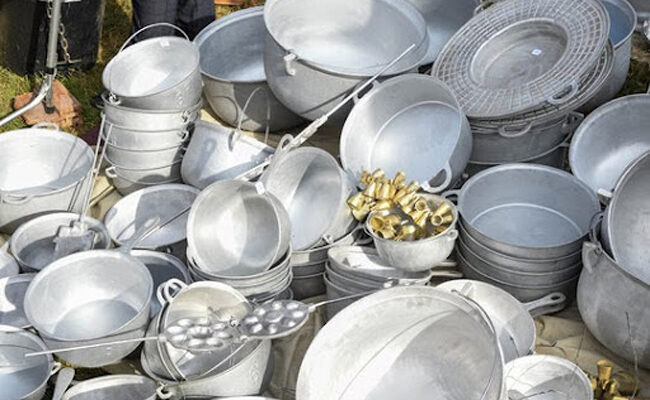
Since ancient times a variety of metals have been used in the form of tools to aid us in carrying out many different activities. One of these very important activities was cooking food. Not just any metals could be used for the purpose.Unlike any other activity, the tools or utensils required for cooking needed to be not only suitable for heating but more importantly safe for cooking. This is so because of the general properties of metals – they possess the ability to react with other elements and change the properties of anything that comes in contact with them. There was a certain need for caution, and only some metals could be safely used for cooking. Thus, often they were recommended in differing ratios of composition for making utensils by the ancient scientists, and different metal utensils were used for cooking different kinds of foods too.
But this property of metals is not necessarily bad. Metals and minerals are also required by our bodies (since our bodies don’t produce them by themselves), even in trace amounts for a host of different functions. Consuming them definitely gives us the benefit of good health, which is why they have been used for the longest time in many ancient civilizations, in some of which they have even been extolled for their nourishing properties, such as in our very own ancient practice of Ayurveda.
Ayurveda has always placed a lot of emphasis on the quality of food we consume with the aim of preserving our health. Therefore it has recommended the use of different metals in the kitchen as part of our cooking process. Using cooking utensils made out of pure metals and even alloys was a great way of ensuring we received a variety of minerals via our food.
These ancient cooking practices have stood the test of time and are relevant to this day, even though many of these have been long given up. Old metal cooking utensils have been ousted from our kitchens and replaced with modern steel, aluminuim and nonstick cookware. However, these are not obsolete and neither are they dead just yet. These scientific practices are making a comeback, and we are here to introduce you to one such age-old cooking practice – using Bronze Cooking Utensils for the preparation of food.
Back to the Bronze Age
Bronze is a golden coloured metal, an alloy made out of copper primarily along with a smaller percentage of tin. In the Indian kitchens it is known as peetal, deriving from the sanskrit ‘peet’ meaning yellow or gold.
Ever since copper was discovered and used to make tools during the Bronze age, it was found to be an excellent utensil for cooking used across many civilizations. The Indian civilization and the ancient sages of Ayurveda of the time of the Bronze age too recognised its many amazing properties.
Harnessing the power of copper
That Copper is the best conductor of heat (after silver) is a well-known fact, making it an excellent choice for the purposes of cooking. But it also has the ability to balance all the three doshas – Vata, Pitta, Kapha, integral to maintaining a healthy body metabolism in our body. Copper is also a natural purifier with anti-microbial, alkaline, and immunity building properties.
Although copper is reactive to sour or acidic items, something’s that are not strange to the Indian kitchen. Therefore, it was carefully crafted into alloys in order to make it suitable for the dual purpose of cooking as well as enriching our food. And so Bronze came to be, inheriting the heating and nourishing properties of its parents, forming some of its own unique ones.
The unique properties of Bronze
Bronze is hypersensitive to heat, and like copper is an excellent conductor. Bronze Cooking Utensils are thick and heavy therefore especially suitable for cooking foods that need slow cooking such as curries and biryani or get burnt or overcooked easily. In many homes, Bronze Cookware was especially used to boil milk.
Pital is made by combining copper with tin – a purifying metal. It’s also coated with a layer of tin, known as kalai to make it safe and nonreactive. Owing to tin, bronze is considered as Shudh Dhaatu in our culture and is specifically used in many rituals. Tin also lends bronze strength and high resistance so that any piece of Bronze Cookware lasts years with minimal corrosion, breakage or wear and tear.
The tin lining not only protects the vessels from corrosion and the food from direct contact with copper, it also enables the transmission of all the properties of copper to the food being cooked in it. So the result is nutritious food with its authentic taste and rich flavours preserved.
Bronze utensils are an asset in your kitchen. Preserve them! If you don’t have any, maybe it’s time to bring them home. Get yourself Bronze cookware made by traditional craftsmen from rural India who have mastered the art of making bronze utensils over generations brought to you by Zishta. There’s a collection of uniquely designed and painstakingly crafted cookware and serve ware waiting to find its way to your home.
Explore the collection here.
Leave a Reply